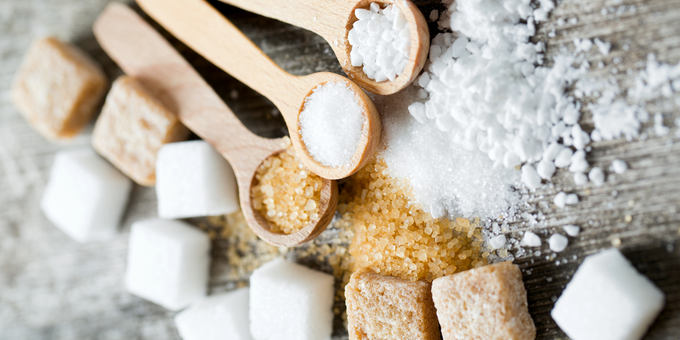You’ve double checked the ingredients on all of your groceries, relieved to find there's no added sugar in sight. So it's all clear, right? Well, not quite. There are tens upon tens of deceptive names companies continue to confuse shoppers with, so we decided to compile the 57 names to look out for.
Considering global obesity rates are soaring through the roof – having tripled in the last 47 years – and with researchers finding sugar to be directly linked with this phenomenon – it’s no wonder shoppers are keen to keep this addictive stuff out of their food. This can prove challenging, considering the sizeable list of names sugar is disguised under, so we’ve decided to make it easier for everyone by unveiling each one. If you see any of the following on the ingredient list – it’s sugar.
Basic sugars: monosaccharides
Monosaccharides, also known as simple sugars, are those which cannot be hydrolysed to form a simpler sugar. To break it down further, sugar is made up of sucrose, which in turn is made up of two other types of sugar: glucose and fructose – both of which are monosaccharides. One of the most dangerous simple sugars is fructose, this is because it cannot be further broken down by the body and, unlike glucose, which is absorbed into the small intestine and able to be used as energy, fructose requires the liver to metabolise it.
That’s where the problem starts. If we consume fructose in excess – which isn’t hard to do considering the average Aussie is downing 15 teaspoons of sugar a day; that’s over double the recommended limit for women – our livers just can’t handle it. The result is the development of visceral fat, which can lead to everything from obesity to diabetes, liver disease and heart disease. That’s why you’ll want to know whether this sneaky sugar is hiding in your cupboard.

Take a look at the sugars classified as monosaccharides – if you find these on the ingredient list, you’ll know you’ve been “sugared”.
- Glucose
- Fructose
- Ribose
- Mannose
- Galactose
- Dextrose
Disaccharides
Disaccharides are made up of two molecules of the sugars from the above list – monosaccharides – which are bonded to each other. They are water-soluble and commonly found in range of products, from baked goods to cereal, bread and milk. You may also hear disaccharides referred to as double sugar.
- Lactose
- Maltose
- Sucrose
- Brown sugar
- Beet sugar
Liquid sugars
Liquid sugars are particularly sneaky, with names like “brown rice syrup” and “carob syrup”, you’d be forgiven for thinking these were health foods. While, in moderation, it’s okay to use these ingredients, it’s important to know that they are, in fact, sugar. One of these sugars, high-fructose corn syrup, has a well-earned reputation as a key driver of the global obesity crisis. Since its mass introduction into household staples, from yoghurt and muesli bars to bread, cereal and confectionery, research has found a drastic rise in diabetes rates directly linked to this syrup.
- Agave nectar
- Barley malt
- Blackstrap molasses
- Buttered sugar
- Fruit juice
- Fruit juice concentrate
- Golden syrup
- Honey
- Invert sugar
- Malt syrup
- Molasses
- Refiner’s syrup
- Treacle
- Evaporated cane juice
- Corn syrup
- Carob syrup
- Coconut syrup
- Caramel
- High-fructose corn syrup
- Rice syrup
- Brown rice syrup
- Maple syrup

Granulated and solid sugars
- Cane juice crystals
- Cane sugar
- Castor sugar
- Demerara sugar
- Coconut sugar
- Confectioner’s sugar
- Crystalline fructose
- Golden sugar
- Grape sugar
- Icing sugar
- Muscovado sugar
- Panela sugar
- Raw sugar
- Granulated or table sugar
- Turbinado sugar
- Yellow sugar
- Date sugar
- Corn syrup solids
- Dextrin
- Diastatic malt
- Ethyl maltol
- Florida crystals
- Glucose syrup solids
- Maltodextrin
Whew, that’s a long list. Don’t fall for the sugar industry’s tricks and traps – remember to opt for whole foods, like fresh fruit and veg, whole grains, nuts and seeds, and keep the highly processed goods to a minimum.
If you’re in need of a little extra help navigating our sugar-laden world and kicking your addiction, we’re here to help. Join us for our 8-Week Program where we’ll be ditching sugar and taking back control of our health. When you sign up to the program, you’ll have access to extensive plans, community support and exclusive access to our sugar-free content. Here’s what’s on offer:
- 8 weeks of expert-crafted meal plans and shopping lists.
- 90+ member-only recipes.
- Community forums to share your journey.
- Support from the I Quit Sugar team, plus our panel of experts.
- Mental and physical health benefits that last a lifetime.
If you’re ready to transform your health and say goodbye to sugar crashes, JOIN NOW!






Leave a comment (all fields required)